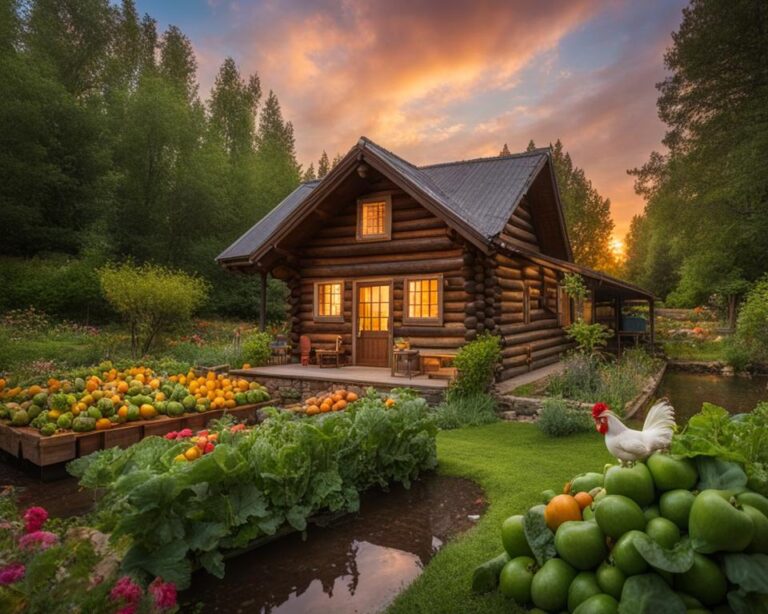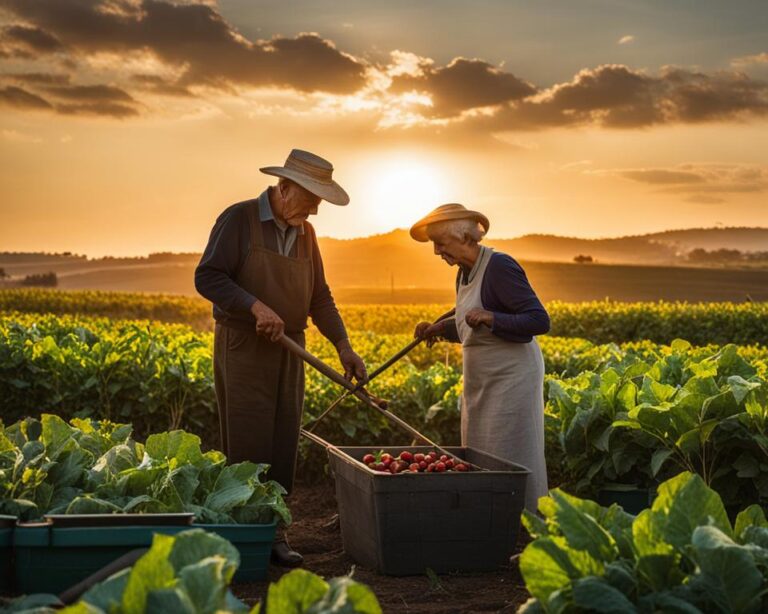Victory Gardens Explained: Revive the War-Time Trend
Welcome to our article series on Victory Gardens! In this series, we will explore the history, benefits, and revival of this fascinating wartime trend. Whether you’re a seasoned gardener or just getting started, victory gardens have something to offer for everyone.
So, what is a victory garden? Simply put, it’s a way to grow your own food and support the war effort. Victory gardens gained popularity during World War II when they provided a reliable source of food for families and reduced stress on wartime rations. By planting victory gardens, Americans felt connected to the war effort and contributed to the overall resilience of the nation.
The History of Victory Gardens
The victory garden movement played a significant role during both World War I and World War II, as it aimed to promote self-sufficiency, alleviate stress on the food supply, and support the war effort. Victory gardens encouraged Americans to cultivate their own food in any available space, whether it be rooftops, fire escapes, empty lots, or backyards.
These gardens were a symbol of resilience and unity, as they allowed citizens to actively contribute to the war effort while providing a reliable source of fresh produce. The concept behind victory gardens was simple: by growing their own food, Americans could reduce the pressure on the nation’s resources and support soldiers on the front lines.
“We must turn home yards into vegetable gardens.” – Charles Lathrop Pack, National War Garden Commission Chairman
Victory gardens became a widespread movement, with the government and private companies joining forces to provide educational materials, funding, and resources to eager gardeners. Citizen participation was encouraged through instructional booklets, public campaigns, and community programs. These initiatives aimed to teach individuals how to garden effectively, preserve their produce, and maximize their gardens’ yields.
The history of victory gardens is a testament to the resilience and resourcefulness of the American people during times of adversity. It exemplifies the power of collective effort and the impact that individuals can make towards a common goal.
Throughout history, victory gardens have demonstrated their ability to strengthen communities and promote self-sufficiency. In the next section, we will explore the numerous benefits that victory gardens offer, both during times of war and in our modern era.
Benefits of Victory Gardens
Victory gardens had several benefits during wartime. They provided a reliable source of food when canned goods were rationed, there were labor shortages, and it was difficult to transport fresh produce to market. Victory gardens also reduced stress on wartime rations and overseas supplies.
Growing our own food allowed us to feel connected to the war effort and support our soldiers. Victory gardens were seen as a way to save money, improve health, and increase self-sufficiency.
By tending to our own gardens, we not only ensured a steady supply of fresh, nutritious food for ourselves and our families, but we also contributed to the overall food security of the nation. It gave us a sense of empowerment and played a crucial role in relieving stress on the food supply during times of crisis.
“Victory gardens gave us the ability to take control of our own food supply and reduce our dependence on imported goods. It was a powerful way to show our commitment to the war effort and support our troops.” – Sarah Thompson, Victory Garden Enthusiast
Moreover, victory gardens had a positive impact on our physical and mental well-being. Gardening provided a productive and therapeutic outlet, helping us stay active, reduce stress, and connect with nature. It was a way to bring beauty and life to our surroundings, even during challenging times.
Starting a Victory Garden
Are you ready to embark on your own victory garden journey? Starting a victory garden is a simple and rewarding way to contribute to your self-sufficiency and embrace sustainable living. Here are some steps to help you get started:
- Evaluate Your Space: Assess the available space you have, whether it’s a backyard, balcony, or even a windowsill. Victory gardens can be adapted to fit any space, so don’t be discouraged if you have limited room.
- Select Your Plants: Choose plants that are suitable for your region and space constraints. Consider growing vegetables like tomatoes, peppers, lettuce, herbs, or even fruits like strawberries. Research which plants thrive in your area and can be easily maintained.
- Prepare the Soil: Ensure your soil is nutrient-rich by adding compost or organic matter. This will provide the necessary nutrients for your plants to grow and thrive. If you have limited space, consider using containers or raised beds with quality soil mix.
- Plant and Water: Follow the planting instructions for each plant, including proper spacing and depth. Water your plants regularly, providing adequate moisture without overwatering.
- Maintain and Nurture: Keep an eye on your plants for any signs of pests, diseases, or nutrient deficiencies. Remove weeds regularly to prevent competition for resources. Provide support, such as stakes or trellises, for plants that need it.
- Harvest and Enjoy: Once your plants have matured, harvest your homegrown produce and savor the taste of your success. Share your bounty with family and friends or consider preserving excess produce for later use.
“Starting a victory garden is not only a practical endeavor but also a way to reconnect with nature and the food we eat.”
Remember, victory gardening is not just about the end result, but the journey itself. Embrace the process, learn from your experiences, and adapt as needed. By starting a victory garden, we can all contribute to a more sustainable and resilient future while enjoying the satisfaction of growing our own food.
Reviving the Victory Garden Movement
The victory garden movement has been experiencing a resurgence, particularly during times of crisis such as the COVID-19 pandemic. Fears of food shortages and the desire for self-sufficiency have led people to embrace victory gardening once again. This time, everyday people have taken the lead, starting gardens in whatever spaces they have available.
The movement encourages utilizing even small spaces, such as containers and windowsills, and promotes less labor-intensive gardening methods like no-till gardening and square foot gardening. The emphasis is on every bit of homegrown food helping, even if it doesn’t meet all of one’s needs.
Educational Resources for Victory Gardeners
As victory gardeners, we are fortunate to have access to a wealth of educational resources to guide us on our gardening journey. Whether you are a beginner or an experienced gardener, there are resources available to help you learn and improve your skills. Both government agencies and private companies have developed materials that cover everything from planting to preserving your harvest.
Instructional booklets are a valuable resource for victory gardeners. These booklets provide step-by-step instructions and practical tips on topics such as soil preparation, planting techniques, pest control, and harvesting. They often include helpful illustrations and diagrams to ensure that you understand the concepts clearly.
Online articles are another excellent source of information for victory gardeners. These articles cover a wide range of gardening topics in detail, such as choosing the right plants for your region, organic gardening practices, and sustainable gardening methods. You can easily find articles on specific gardening techniques or explore broader topics related to victory gardens.
In addition to written materials, there are also numerous video resources available. YouTube has a vast selection of gardening channels that offer tutorials, demonstrations, and expert advice. These videos allow you to visually learn various gardening techniques, from seed starting to transplanting. Watching experienced gardeners in action can be both informative and inspiring.
“Gardening is the art that uses flowers and plants as paint and the soil and sky as canvas.”
Joining gardening clubs is another way to access valuable resources. These clubs bring together like-minded individuals who share a passion for gardening. By joining a club, you can attend workshops, participate in group gardening projects, exchange tips and ideas, and even borrow gardening tools. The camaraderie and support provided by these clubs can significantly enhance your gardening experience.
With the rise of social media, online communities have become increasingly popular among victory gardeners. These communities allow gardeners to connect, ask questions, and share their experiences. You can join Facebook groups, follow gardening hashtags on Instagram, or participate in gardening forums. These platforms provide a space where you can interact with fellow gardeners, seek advice, and showcase your own victories in the garden.
The Benefits of Gardening Education
By availing yourself of these educational resources, you not only acquire the knowledge and skills necessary to become a successful gardener, but you also gain a deeper understanding of the wider benefits of victory gardening. These resources often emphasize the patriotic significance of victory gardens, reminding us that by growing our own food, we contribute to the collective effort and resilience of our nation.
Gardening education also highlights the health benefits of victory gardening. It encourages us to appreciate the nutritional value of fresh, homegrown produce and the positive impact it has on our well-being. Learning about organic gardening practices and sustainable gardening methods can help us reduce our reliance on chemical pesticides and fertilizers, promoting a healthier environment for ourselves and future generations.
So, take advantage of the educational resources available to you. Expand your gardening knowledge, refine your skills, and join a community of passionate victory gardeners. Together, we can cultivate our gardens and sow the seeds of self-sufficiency, resilience, and a sustainable future.
The Impact of Victory Gardens
During both World Wars, victory gardens had a significant impact on the food supply and the overall war effort. These gardens, cultivated by millions of Americans, played a crucial role in ensuring a steady and reliable source of fresh vegetables during a time of scarcity and rationing.
By the year 1943, victory gardens in the United States numbered over 20 million, producing an astonishing 40% of all vegetables grown in the country. This impressive output not only relieved stress on the food supply but also provided much-needed sustenance for both civilians and soldiers.
By growing their own food, Americans directly contributed to the war effort. Every carrot, tomato, and cabbage harvested in a victory garden meant one less vegetable that needed to be transported, leaving more resources available to support the troops on the front lines.
In addition to their direct impact on the food supply, victory gardens promoted self-sufficiency and resilience among individuals and communities. By taking control of their food security, Americans gained a sense of empowerment and independence, reducing their reliance on external sources.
The impact of victory gardens extended far beyond the practicality of growing vegetables. They fostered a sense of unity and purpose, bringing people together and reinforcing the collective spirit of the nation during a time of hardship.
“We were not only growing food to sustain ourselves, but we were also growing hope, unity, and pride in our ability to contribute to the war effort. Victory gardens gave us a tangible way to support our troops and make a difference.”
The legacy of victory gardens lives on to this day, serving as a reminder of the resilience and resourcefulness that can be found in times of crisis. As we face new challenges, the lessons learned from the victory garden movement can continue to inspire us to embrace sustainable practices, foster community connections, and take control of our own well-being.
Embracing Victory Gardens for Sustainability and Resilience
Reviving the victory garden trend is not just about growing food during times of crisis, but also about embracing sustainable and resilient living. Victory gardens promote self-sufficiency, reduce reliance on industrial agriculture, and encourage healthy eating habits.
By growing our own food, we become more connected to the earth, understand the effort it takes to produce food, and appreciate the value of fresh, homegrown produce. Victory gardens empower us to take control of our own food supply and make informed choices about what we eat.
Furthermore, victory gardens provide an opportunity to engage with nature and teach gardening skills to future generations. As we cultivate our own fruits, vegetables, and herbs, we not only nourish our bodies but also foster a sense of achievement and pride.
By participating in the victory garden movement, we can contribute to a more sustainable and resilient food system. Growing food in our own backyard reduces transportation emissions and our carbon footprint. It also allows us to support local ecosystems by nurturing beneficial insects and wildlife.
Let us embrace victory gardens as a means to promote sustainability, resilience, and a closer relationship with the food we eat. By doing so, we can play our part in creating a more secure and self-reliant future.







